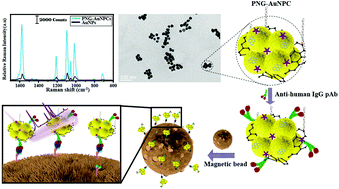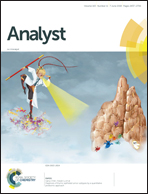PEGylated nanographene-mediated metallic nanoparticle clusters for surface enhanced Raman scattering-based biosensing†
Abstract
Surface-enhanced Raman scattering (SERS) is an optical spectroscopy technique that can detect a variety of analytes with high sensitivity and selectivity without any labels. Controlled clustering of metallic nanoparticles to prepare a new class of SERS nanotags is crucial for the ultra-sensitive detection of specific biological and chemical moieties because increased plasmonic hotspot junctions produce a greatly enhanced SERS signal. We report herein that controlled clustering of Au nanoparticles (AuNPs) was mediated by PEGylated nano-sized graphene (PNG) and that the PNG-induced AuNP clusters (PNG-AuNPCs) were highly sensitive SERS nanotags with colloidal stability for SERS-based biosensing. The AuNPs labeled with 4-mercaptopyridine as a Raman reporter were surface-modified with 1-aminomethylpyrene for the introduction of hydrophobic moieties, and were non-covalently complexed with PNG via π–π stacking and van der Waals forces. It resulted in the formation of PNG-AuNPCs that increased SERS intensity with an enhancement factor of 1.34 × 1011. The PNG induced a high degree of AuNP clustering by enhancing the non-covalent interactions between them, resulting in increased hotspot junctions at highly localized plasmonic centers. Furthermore, to show that the PNG-AuNPCs would serve as stable, reproducible, and highly sensitive SERS nanotags for biosensing, we formed sandwich-type immunocomplexes composed of the PNG-AuNPCs, immunoglobulin G (IgG) as the antigen, and magnetic beads. We found a linear relationship between SERS intensity and IgG concentration, with a limit of detection lower than 31.0 fM for IgG detection. Thus, the PNG-AuNPCs could be useful as SERS nanotags for highly sensitive SERS-based biosensing applications.

- This article is part of the themed collection: Editor's choice – Karen Faulds


 Please wait while we load your content...
Please wait while we load your content...